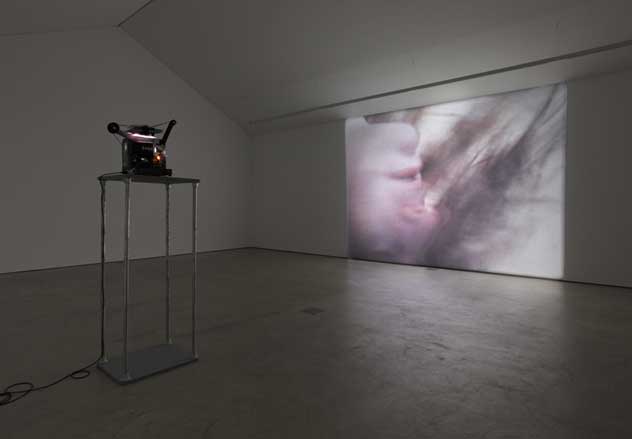New artwork by A K Dolven, Oslo

Tullinløkka’s history has been long and tremulous. The small square next to the Oslo National Museum has historically been a central meeting point for political gatherings and manifestations since its creation in the 19th century but, when several plans to give it an architectural facelift were shelved, it gradually fell into disuse.
Enter London-based Norwegian artist, A K Dolven, whose plans to revive the historical square were set in motion by Public Art Norway (KORO) - the government’s professional body for art in public spaces. 'I wanted to look ahead and think positively, instead of being part of an ongoing negative discussion full of complaints about the past. When I was asked to do something in the square, I realised that the sky was the only really open and beautiful surface to work against,' she says. The aim of the installation was to create something that could, at least temporarily, turn around the site’s current state of neglect.
Taking into account the plot’s size and visual diversity (its historical National Museum building sits alongside an almost futuristic, metal-clad pavilion on stilts), Dolven knew that she had to work on something minimal and very visually and conceptually focused, in order for the piece to work within the landscape. The solution was found in an old 1.5 ton D-sharp bell, which was removed from the Oslo Town Hall chimes, when found to be out of tune.
'A bell hung high up, at the same height as the existing buildings was my first idea for the piece. Something which the passer-by would be able to activate, as this had to be primarily a personal experience. When, during my research for a bell, I found the "Untuned Bell", I knew immediately that it should naturally be the one to go for and the art piece started to grow organically from there,' explains Dolven.
The artist created and directed the Untuned Bell installation, working with Kristine Jærn Pilgaard, who curated and managed the project, while Copenhagen-based architect Trude Mardal designed the structure. Hanging 20m above ground and suspended from a steel wire between two pillars, the bell can be rung from ground level, when visitors step on a pedal in the middle of the square.
The relationship between man and landscape is one of Dolven’s recurring themes. If you cannot be in Oslo to experience the bell, the artist is currently exhibiting at London’s Wilkinson Gallery. ‘The Day The Sky Became My Ground’, which runs until 14 March, shows two pieces that explore further the poetic relationship between the body and Norway’s cold and snowy white landscape.
Receive our daily digest of inspiration, escapism and design stories from around the world direct to your inbox.
Back in Oslo, A K Dolven's installation invites passers-by to enter the square, while referencing Tullinløkka’s history and combining it with interactivity and sound. In the few days since its launch, the Bell has already enticed new visitors to the square and a dialogue has certainly started. So what's next? 'Should it stay?' asks Dolven. 'I am not sure that would be right. I see it as a temporary voice, making the square visible again. You use the pedal and then looking up towards the sky, you can hear the bell’s sound. This is an interesting start, but for the future, nothing is decided at all.'

The bell hangs high above Tullinløkka square, next to the Oslo National Museum

The National Museum building sits alongside an almost futuristic, metal-clad pavilion on stilts

Ahead, 2008, by A K Dolven. HD video projected on 6-8m tilted screen. Courtesy of the Wilkinson Gallery

Ahead, 2008, by A K Dolven. HD video projected on 6-8m tilted screen. Courtesy of the Wilkinson Gallery

The day the sky became my ground, 2009, by A K Dolven. 16mm film projection, mute on a looper. Courtesy of the Wilkinson Gallery

The day the sky became my ground, 2009, by A K Dolven. 16mm film projection, mute on a looper. Courtesy of the Wilkinson Gallery

Self portrait, by A K Dolven: Berlin, February 1989; Lofoten, August 2009, 2010. Two 8mm films transferred to two channel video, mute. Courtesy of the Wilkinson Gallery
-
 For Rodríguez + De Mitri, a budding Cuernavaca architecture practice, design is 'conversation’
For Rodríguez + De Mitri, a budding Cuernavaca architecture practice, design is 'conversation’Rodríguez + De Mitri stands for architecture that should be measured, intentional and attentive – allowing both the environment and its inhabitants to breathe
-
 A compact Scottish home is a 'sunny place,' nestled into its thriving orchard setting
A compact Scottish home is a 'sunny place,' nestled into its thriving orchard settingGrianan (Gaelic for 'sunny place') is a single-storey Scottish home by Cameron Webster Architects set in rural Stirlingshire
-
 7 colours that will define 2026, from rich gold to glacier blue
7 colours that will define 2026, from rich gold to glacier blueThese moody hues, versatile neutrals and vivid shades will shape the new year, according to trend forecasters